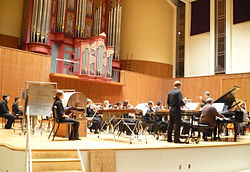- Des canyons aux étoiles...
-
Des canyons aux étoiles… (From the canyons to the stars...) is a large twelve-movement work (between 90 and 100 minutes in length) by the French composer Olivier Messiaen. It was written to a 1971 commission by the American Alice Tully for a work to celebrate the bicentenary of the United States Declaration of Independence. It was first performed in 1974.
While preparing the work, Messiaen visited Utah in 1972, where he was inspired by the landscape and its birds, and particularly Bryce Canyon and its colours (Messiaen had bi-directional sound-colour synaesthesia; see also modes of limited transposition). The work is also notable for its use of modern instrument techniques.
The ensemble is scored for piano solo, horn solo, xylorimba solo and glockenspiel solo. The small string section consists of 6 violins, 3 violas, 3 cellos, and 1 double bass with fifth-string lower extension. The woodwind requires 1 piccolo, 2 flutes, 1 alto flute, 2 oboes, 1 cor anglais, 2 bassoons, 1 contrabassoon, 1 E-flat clarinet, 2 B-flat clarinets and 1 bass clarinet. In addition to the sixth movement's horn solo, the brass section also consists of 2 horns, 2 trumpets in c, 1 trumpet in d, 2 trombones, and 1 bass trombone. The large percussion section, divided for 5 percussionists, consists of Messiaen's own invented instrument the geophone, 1 wind machine, 1 thunder sheet, 1 gong, 1 set of tuned gongs, 1 set of tubular bells, 1 pair of maracas, 1 whip, 1 bass drum, 1 triangle, 1 wood block, 1 set of wooden wind chimes, 1 set of crotales, 1 reco reco, and 1 tumba, among other percussion instruments.
 The 2008 Ohio premiere performance of Des canyons aux étoiles…. On the left can be seen some of the more unusual percussion instruments called for in the work, including a thunder sheet and wind machine.
The 2008 Ohio premiere performance of Des canyons aux étoiles…. On the left can be seen some of the more unusual percussion instruments called for in the work, including a thunder sheet and wind machine.
The movements are as follows:
- Le désert ("The desert")
- Les orioles ("The orioles")
- Ce qui est écrit sur les étoiles ("What is written in the stars")
- Le cossyphe d'Heuglin ("The white-browed robin-chat")
- Cedar Breaks et le don de crainte ("Cedar Breaks and the gift of awe")
- Appel interstellaire ("Interstellar call")
- Bryce Canyon et les rochers rouge-orange ("Bryce Canyon and the red-orange rocks")
- Les ressucités et le chant de l'étoile Aldebaran ("The resurrected and the song of the star Aldebaran")
- Le moqueur polyglotte ("The mockingbird")
- La grive des bois ("The wood thrush")
- Omao, leiothrix, elepaio, shama ("Omao, leiothrix, ʻelepaio, shama")
- Zion Park et la cité céleste ("Zion Park and the celestial city")
The piano is treated as a solo instrument throughout the work, with the fourth and ninth movements being extended piano cadenzas, while the sixth movement Appel interstellaire is for horn alone. Messiaen specified that the work is in three sections: the first section contains movements 1-5, the second contains movements 6 and 7, and the third section contains movements 8-12.
References
- Hill, Peter and Simeone, Nigel (2005). Messiaen. Yale University Press, New Haven and London. ISBN 0-300-10907-5.
- Griffiths, Paul (1985). Olivier Messiaen and the Music of Time. Cornell University Press, Ithaca, New York. ISBN 0-8014-1813-5., particularly chapter 13, "From the Canyons to the Stars"
Categories:- Compositions by Olivier Messiaen
- 1974 compositions
Wikimedia Foundation. 2010.

